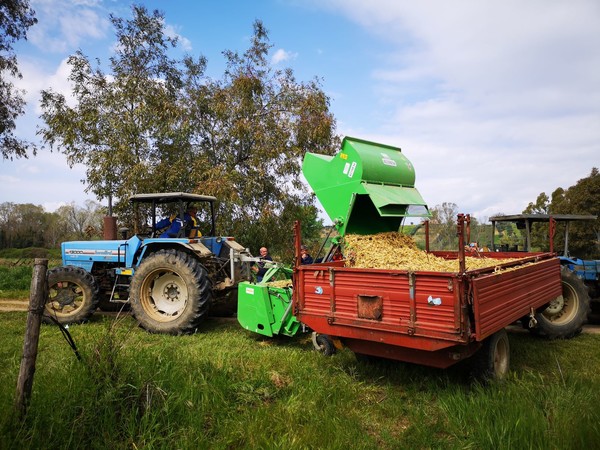
Different mechanized sites for harvesting biomass for pruning in Southern Italy
A mulcher produced by Peruzzo di Curtarolo (PD) was used to collect pruning residues from various tree crops. By measuring the multiple harvesting parameters and comparing the different productions, it has been possible to establish the most efficient mechanized supply chains. The citrus fruit harvesting site showed the best production capacity, followed by the pear and apple tree sites
In Italy, orchards cover almost 1.4 million hectares and produce vast biomass quantities every year from pruning, which usually represents a management cost.
The materials are often burned in the open field, a solution no longer allowed by the current legislation, because of the obvious problems entailed. MIPAAF has recently funded the Research Project “FAESI - Agro-energy chains in Southern Italy" to obtain sustainable energy from different tree crops' pruning residues. The aim is to promote proper alternative use, aimed at the production of sustainable energy, at the same time generating an additional source of income for farmers. Notably, Calabria shows a potential of 290,000 t/year of lignocellulosic biomass for citrus fruits, olive trees, and vines.
With particular reference to the enhancement of this raw material, a research activity concerning the “Study of mechanized sites for the collection of lignocellulosic biomasses" has recently been carried out with the aim of analyzing the organization and productivity of pruning sites for citrus groves, olive groves, and other orchards using the Peruzzo Cobra Collina 1600 shredder. A particular focus has been devoted to studying the shredder working in different operating conditions, which vary according to the nature of the biomass and the characteristics of the coupled tractor, the arrangement of the windrows, etc... An assessment of the costs of the construction sites taken into consideration has also been carried out.
Harvesting sites
The experimental tests have been carried out at the Regional Agency's demonstration centers (CSD) for the Development of Agriculture in Calabria (ARSAC). The residues generated by pruning were arranged in swaths by the ARSAC demonstration center staff before the actual harvesting phases.
The Peruzzo COBRA Collina 1600 shredder is built on a patented rotor with fixed teeth, driven by the tractor's power take-off, to produce even-sized wood chips, then conveyed into a 1.5 m³ storage tank.
Labor productivity
Following the CIOSTA methodology, productivity has been referred to operating time (TO), taking into consideration: the effective time required for waste collection (TE); the machinery maintenance ancillary time while working (TAC); the ancillary time for the turns and the passage from one row to the other (TAV); the ancillary time for loading and unloading (TAS); the preparation time at the workplace (TPL); the avoidable dead time (TM).
Besides the technical analysis costs have also been estimated, divided into fixed and variable components, considering, particularly, the hourly costs of the machinery and labor, considering the unit of mass of the collected material and the processed surface.
Concerning the examined crops, the productivity was 2.21 hours/ha for citrus fruit, 2.51 hours/ha for pear, 4.03 hours/ha for apple, and 7.26 hours/ha for olive. Concerning the operating time, the highest actual TE collection time was measured in the apple tree site, with an incidence of 77.5% of the total, while the lowest value was recorded for the olive tree (44.3%). In this latter, the ancillary time for the discharge of collected biomass (TAS) was 46.3% of TO because of the unavailability of a trailer for the immediate discharge of biomass, as was the case in the other sites.
As a result, the shredder had to travel a considerable distance to unload, somewhere far away from the collection site. In site B (pear tree) and C (citrus fruits), in addition to the times for turning (TAV) and unloading (TAS), the accessory times also included the time for maintenance (TAC), necessary to correct minor inconveniences, which occurred for a site preparation not wholly adequate. Nevertheless, site C (citrus fruit) showed the best production capacity (1.98 t/hour), followed by sites B (pear) and A (apple) with 1.16 and 1.15 t/hour, respectively. Site D (olive tree) showed the lowest operating capacity, with a 0.80 t/hour value.
Economic analysis
The hourly cost varied between 53.14 €/hour for the olive tree and 88.87 €/hour for the apple tree. It is worth noting that variable costs exceeded 75% at all sites, while the cost per unit of biomass ranged between 30 and 80 euro/ton. Finally, the average cost per unit area is between 147 €/ha for citrus fruit and just under 386 €/ha for olive trees.
Agricultural by-products deriving from tree pruning are a significant source of biomass with high energy potential. The Peruzzo Cobra Collina 1600 shredder has shown its best performance (both from a technical and economic point of view) in citrus fruits, even though some small problems have arisen. Conversely, the lowest values have been found in the olive tree site.








